Updated October 23, 2023
One of the strategies, and challenges, of packing light is to manage if, how, and when to do laundry. The clothes you aren’t wearing are the clothes you need to schlep around from place to place. An essential key to packing light is to pack fewer clothes in fabrics and colours that don’t need to be washed as often, have a plan to keep them clean, and have a laundry packing list to make the task as convenient as possible.
Table of Contents
- Packing tips for doing laundry while travelling
- 1. Assemble a travel wardrobe with laundering in mind
- 2. Familiarize yourself with care labels
- 3. Adopt odour-reducing strategies
- 4. Plan when to do laundry by the load
- 5. Handwash regularly
- 6. Suss out drying options in your accommodation
- 7. Fast track drying
- 8. Conduct a handwashing test
- 9. Book accommodation with washing facilities
- Laundry packing list
Packing tips for doing laundry while travelling
1. Assemble a travel wardrobe with laundering in mind
Consider how easy, and how often, something needs to be washed. For example, travel pants and leggings in darker, neutral colours can be worn for several days without washing. Chances are anything in white or light colours will need to be laundered more often and washed separately from darker colours.
Panties don’t take up much space but when washed daily, three or four pairs can suffice. Reusable panty liners worn on long travel days can help underwear (and trousers or leggings) remain fresher. To help tops remain fresher, underarm sweat vests work for some people.
For travel clothing, choose lightweight, quick-drying fabrics. Anything in merino is a good choice. Not only is it lightweight and perfect for layering, but its odour-resistant properties are legendary. For socks, the same pair of merino socks can be worn for several days, so there’s never a need to pack more than two pairs (in addition to compression socks for long flights). The same holds for base layer shirts that can be worn several times without washing. Merino can be pricey, but laundering less means it lasts longer.
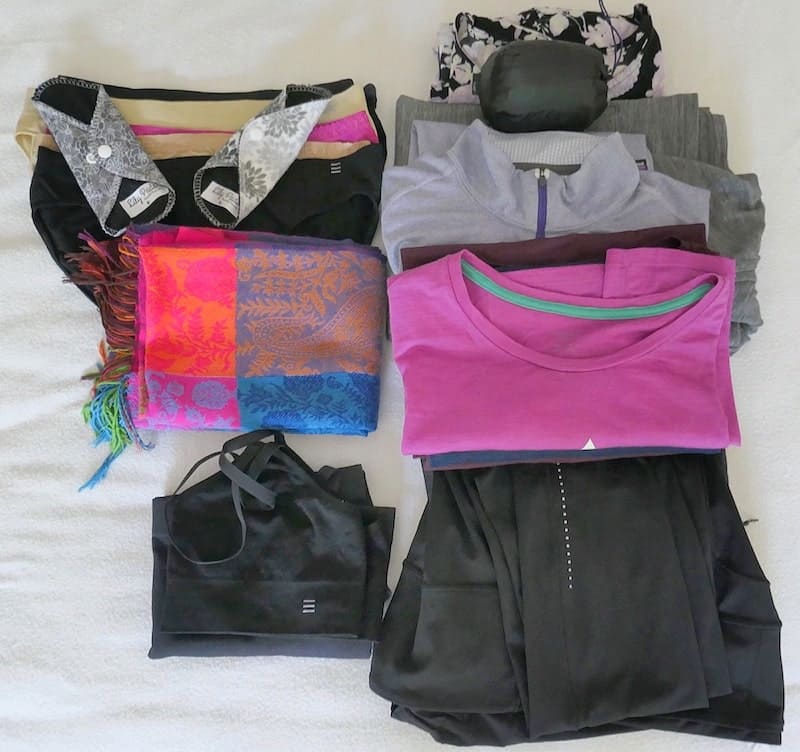
Speaking of merino, let’s talk about shoes. If there are more comfortable walking shoes than AllBirds Wool Runners, I’m yet to find them. My Wool Runners are lightweight, eco-friendly, washable, and in the right colour, blend well with a capsule wardrobe. For sandals, I love my Teva Tirra. They’re also washable and spruce up nicely after time on a sandy beach or dusty trail. Havaianas Slim flip flops are lightweight and durable, and work well as shower shoes, indoor wear, or around water.
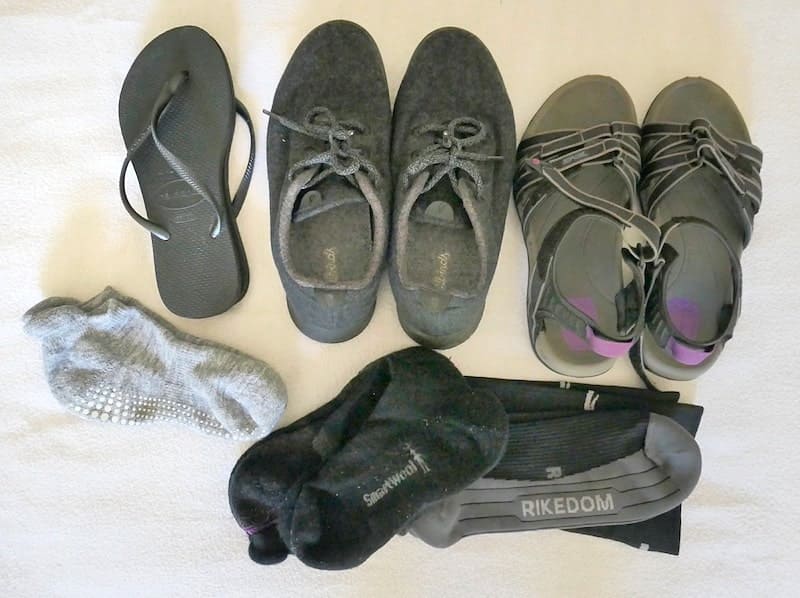
2. Familiarize yourself with care labels
Become familiar with the care labels of your clothing. Know which pieces must be washed in cold water or laid flat to dry. Anything that can’t be washed (except for outerwear) or dry-cleaned deserves to be left at home.
3. Adopt odour-reducing strategies
As previously mentioned, reusable panty liners and underarm sweat vests help reduce odours and extend the time between washing.
Another strategy comes from the performing arts community where costumes need to be worn multiple times. Vodka is a perfect odour remover. It’s odourless, colourless, and has a sanitizing effect. Spritz the offending area with vodka and as it evaporates, the offending odours are removed.
4. Plan when to do laundry by the load
Visiting a self-serve laundromat can be a cultural experience by chatting with locals and learning more about the neighbourhood. However, it consumes valuable travel time that could be invested elsewhere. It also involves figuring out machines and having coins and detergent to operate them.
Another approach is to have a laundry service wash, dry, and fold your clothes, but this requires trust that their products and methods won’t be detrimental to you or your clothes. And charges for services offered by hotels can be excessive.
When staying in holiday accommodation, doing laundry by the load means you’re in charge of detergents and drying methods. It also allows you to do other things while a machine is doing its thing. If there’s no dryer (or air drying is preferred), there will probably be a drying rack and plenty of other places to hang damp clothes and string your travel clothesline.
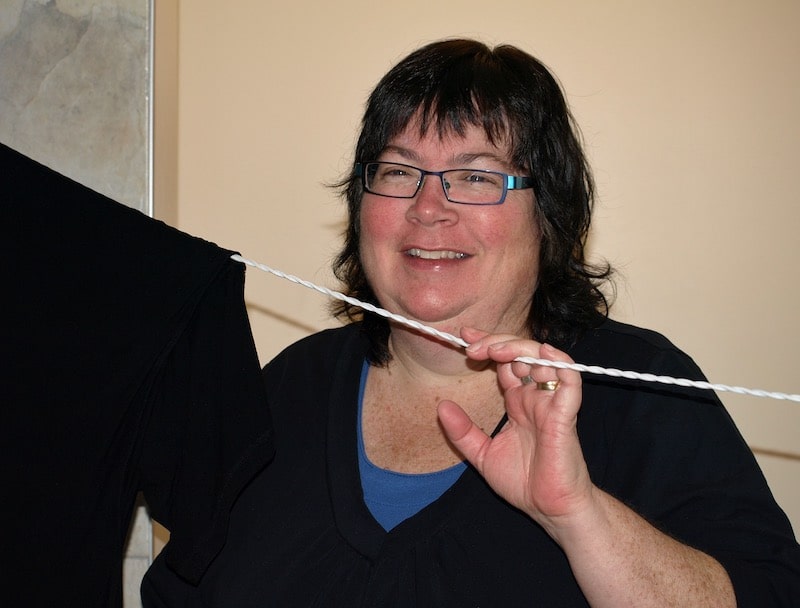
5. Handwash regularly
Handwashing takes a few minutes each evening, and for lightweight and quick-dry fabrics, they’re usually good to go the next day. Unless you’re accumulating laundry to wash by machine at a future stop, washing one or two items daily feels less overwhelming and requires less drying space.
If you like to soak and wash things in a sink, you may have to plan for sinks without plugs, or plugs that don’t work. Also, it’s a good idea to give a sink a good scrub to remove dirt or residue from cleaning products that can stain or discolour clothing.
For areas needing extra attention, such as collars, armpits, and crotch, work on those first. Spend extra time on stained or soiled areas. Then, swirl, swish, and knead the clothing in soapy water for about two minutes.
Another approach is to take dirty items into the shower with you, especially if the sink is lacking in some way. Lather them up, and rinse them off while showering. If the accommodation has a ‘shower bath,’ (bath and shower combo), start by adding a little water and preferred detergent to the tub. While showering, trample, squish, and agitate the clothing with your feet. This works well with larger pieces.
6. Suss out drying options in your accommodation
Hostels, hotel rooms, and holiday apartments offer a variety of places to hang laundry to dry. When staying in a women’s dorm in a hostel, my travel clothesline finds attachment points on the bunk frame. Wooden hangers in hotel rooms and holiday apartments that can be removed from a closet can be hung on a door frame, curtain rod, ironing board, table edge, towel bar, or shower head. Some hangers have clips from which to hang socks or panties. A travel clothesline can be stretched between two stationary objects such as a bed frame, door knob, luggage rack, wall lamp, balcony rail, faucet, towel bar, bathroom hook, dresser handles, or chair.
7. Fast track drying
To expedite the drying process, squish or wring pieces out to remove as much water as possible. Smooth out any twists so clothes dry faster, keep their shape, and have fewer wrinkles. Take a towel, lay it on a flat surface, and place your pieces of wet clothing flat on top of it, separating each item. Then tightly roll the towel with the clothing inside. Once rolled, apply pressure, or step or kneel on the towel to help it absorb more moisture. Unroll the towel to remove your clothes and hang them to finish drying.
If your accommodation has an iron and ironing board, iron those pieces that could benefit from having additional moisture removed. Or use a hairdryer for a similar purpose.
Hanging clothes outdoors in fine weather or near a fan, window, or heat source will help them dry faster. Keep in mind that clothes dry more slowly in humid climates.
8. Conduct a handwashing test
On a recent trip to Poland in September, I packed two bottoms: lightweight travel pants and Lululemon leggings. I was surprised to discover that the leggings needed more than an overnight to dry. Fortunately, I was staying several days in that location, but had I washed them before a travel day, this would have been handy to know. Taking a handwashing test at home might have given me the intel I needed to choose the best time to launder different pieces of clothing.
Another consideration concerns new purchases and how they react to laundering. If they bleed, it’s better to know this before mixing them with other pieces of clothing.
9. Book accommodation with washing facilities
If daily hand washing isn’t your thing, mix up your accommodation bookings to ensure you have access to a washing machine on a schedule that works for you. When I travel with a group of friends, we book accommodation that invariably has washing facilities. We’ll choose a ‘wash day,’ get ourselves organized, and pool our laundry into loads of lights and coloureds.
Laundry packing list
1. Detergent
Many travellers take advantage of what’s available at their accommodation: body wash, shampoo, or bar soap.
If you have a favourite liquid detergent, decant some into travel-sized bottles no larger than 100 ml for carry-on travel. Or purchase packets of travel-sized laundry detergent before leaving home. One advantage, especially for those with skin conditions, is that you can have confidence in a tried-and-true product.
I’m a fan of an all-purpose bar soap. My favourite is Dr Bronner’s 18-in-One Pure Castile Soap. However, the more I use it for laundry, the less I have left as bath soap. It fits perfectly in a Matador Flatpak Soap Bar Case where the bar dries while it remains sealed away. Dr Bronner’s offers the same product as a concentrated liquid in a travel size.
Better still, laundry eco-strips are a carry-on traveller’s dream. They’re ultra-concentrated, biodegradable sheets of ‘liquidless’ laundry detergent that dissolve in water. Use one for a load, two for heavily soiled laundry, or cut them in halves or quarters for laundry in a sink, shower, or a DIY dry-bag ‘washing machine.’ I’ve used Tru Earth with success, but there are many choices on the market, including Earth Breeze that gets excellent reviews and is on my list to try. Laundry sheets are lightweight, earth friendly, take up very little space, don’t leak, and a small piece goes a long way to meeting handwashing needs.
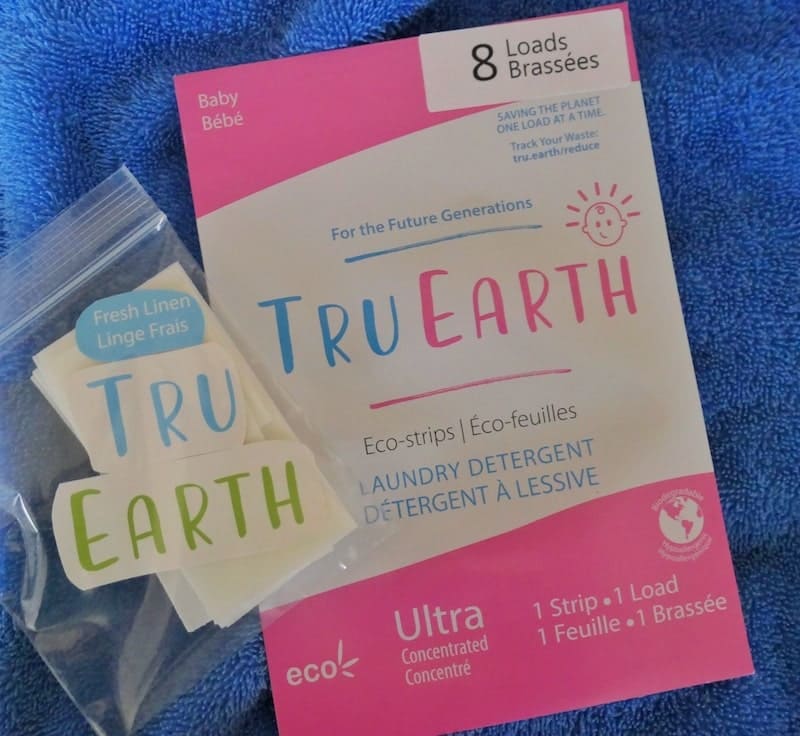
2. Stain removal
For stain removal, a Tide to Go Instant Stain Remover Pen does a decent job. It’s cheap, easy to carry, and perfect for removing stains as they appear.
Or, use hand sanitizer. In an interview with the New York Times, cleaning expert Jolie Kerr stated, “If I had to tell people to carry just one thing with them to handle stains on the fly, it would be hand sanitizer. It has a high concentration of alcohol in it, which is a very good stain remover and will work on everything from pen to food spills to blood.”
As soon as possible, use warm water and regular soap if you don’t have other options at your disposal. Be gentle. You’re trying to tease the stain out of the fabric, not push it deeper. Make short, quick motions as if you’re tugging the offending stain out. It’s not the time for elbow grease.
3. Odour removal
Decant a couple of shots of vodka into a travel-sized spray bottle. Or carry an empty bottle and pick up a miniature bottle of vodka during your travels.
4. Dry-bag ‘washing machine’
A dry bag is a versatile multipurpose item that can serve as a DIY washing machine. It’s especially useful when camping, and a hygienic choice when staying in facilities with communal sinks. Add laundry, water, and detergent, roll out as much air as possible, then shake, toss, tumble, agitate, and massage the bag to replicate the action of a washing machine. Repeat with a rinse cycle.
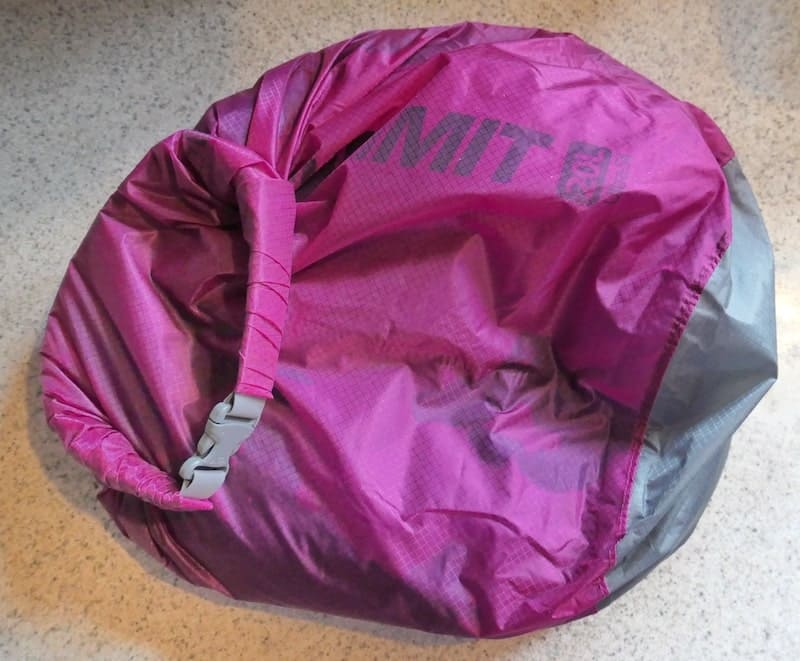
A dry bag is a more durable and earth-friendly alternative to a plastic zip-top or garbage bag. For a commercial option, some travellers choose the ‘Scrubba,’ a bag with a handy built-in washboard, air valve, and see-through window. If you’re likely to get enough use of a Scrubba to justify the space, weight, and price, here’s an excellent review from Pack Hacker that explains how to use it. The Scrubba Mini is a smaller, lighter version.
Also, a dry bag is handy when freshly washed laundry isn’t quite dry on a travel day. Packing almost-dry laundry in a dry bag is better than hanging individual pieces from a travel bag. On arrival at your new digs, remove items from the dry bag to finish the drying process.
5. Sink stopper
Not all sinks have a plug, and a rubber universal sink stopper doesn’t work in all sinks. I’ve used duct tape and cling wrap with some success, and Blu Tack works well as a reusable plug. I pack a small amount, about the size of a golf ball, stored in a lightweight sealable container. At 0.8 oz / 24 g, it’s one gram lighter than my universal sink plug and much more versatile.
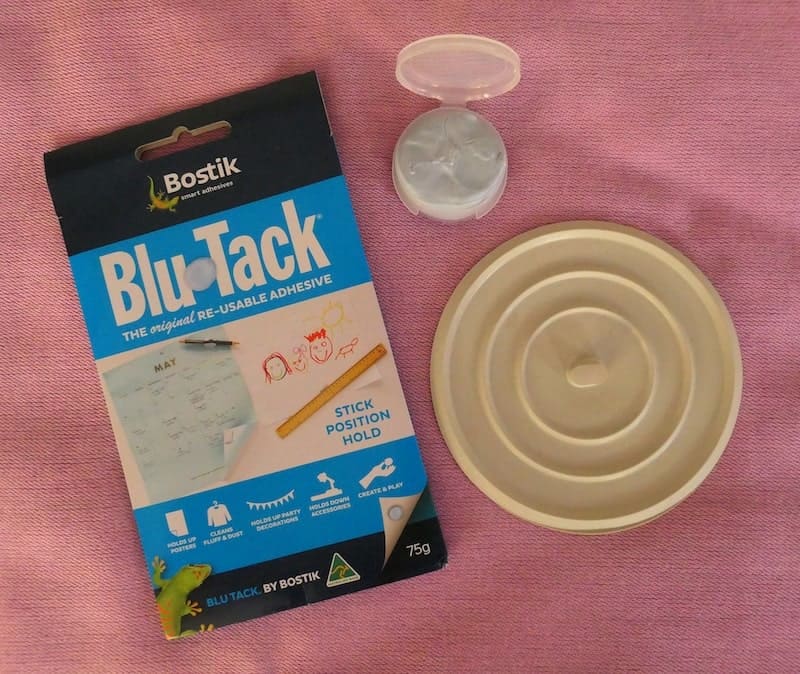
6. Travel clothesline
A retractable clothesline might be available in some types of accommodation. However, a travel clothesline takes up so little space in a travel bag that mine is packed for every trip. It’s lightweight (0.8 oz / 23 g) and doesn’t require clothespins. The hooks at both ends are more serviceable than suction cups. They loop back into the braid, expanding options for setting up the line. My favourite is the Go Travel Pegless Washing Line, with the suction cups left at home. When I stay in hostels, my travel clothesline doubles as a washing line and privacy curtain rod.
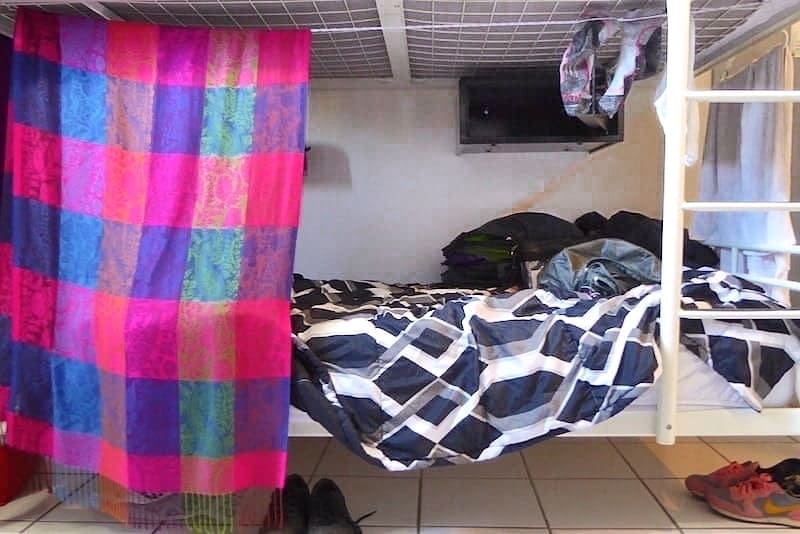
7. Travel hangers and clothes pins
Hangers that can’t be removed from a closet rod reduce drying options. For this reason, travelling with your own offers a tried-and-true approach to hanging laundry. My experience with inflatable hangers didn’t end well when the set of two both developed leaks and were useless. However, they are lightweight and improve airflow by separating layers of clothing from each other. Folding hangers are more reliable. There are a host of possibilities with variations in sturdiness, size, and weight. If hanging clothespins are more your style, these can be hung from a shower rod, towel rack, or back of a chair.
8. Laundry bag
Separating dirty clothes from clean ones makes it easy when it’s time to do a wash. Choose a bag that’s a good fit for you. I wash daily, so a small, lightweight handmade item made by a friend is all I need to stow one or two pairs of panties, a reusable panty liner, a couple of socks, and a merino base layer. An added advantage is that I think of my friend, Rose (who made the gift), whenever I use it.
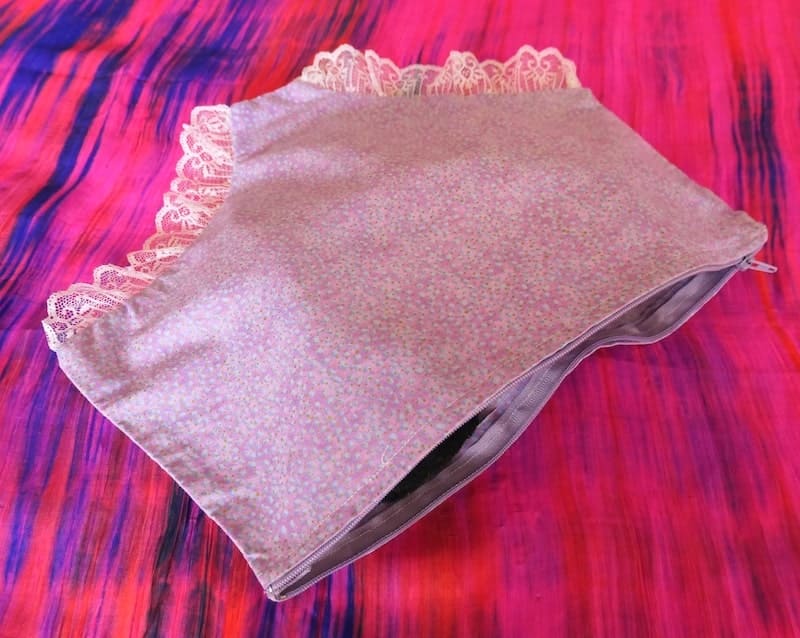
When my handmade laundry bag can’t accommodate damp or dirty items, a dry bag is a useful backup. Might you be interested in this related post?
If you found this post helpful, please share it by selecting one or more social media buttons. What are your strategies and packing tips for planning to do laundry when you travel? Please share your thoughts in the comments. Thank you.
Care to pin for later?
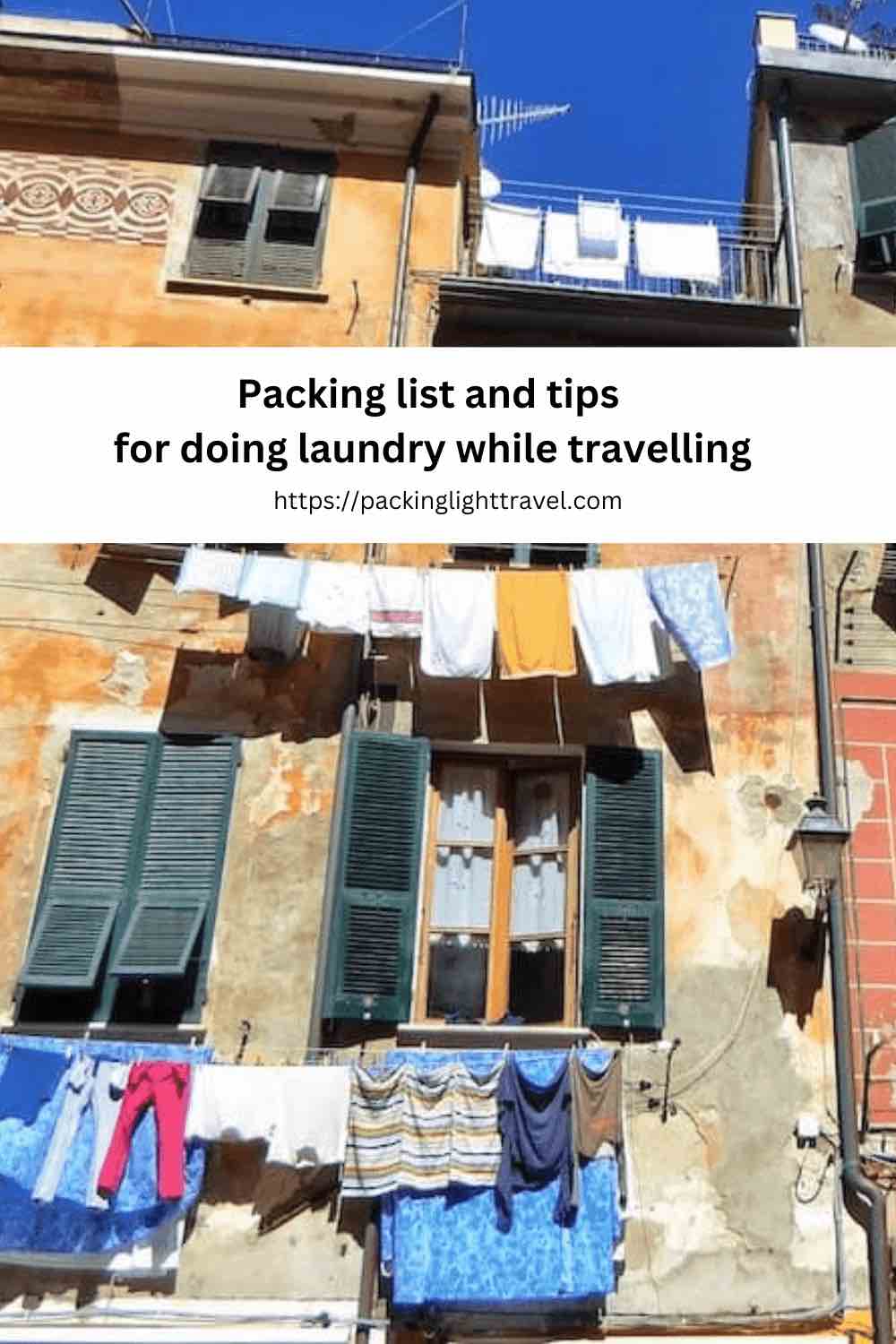
Some of the links are affiliate links. If you click on one and purchase something, you don’t pay more and this site earns a small commission that helps with the costs of maintaining the site. Thank you for your support.

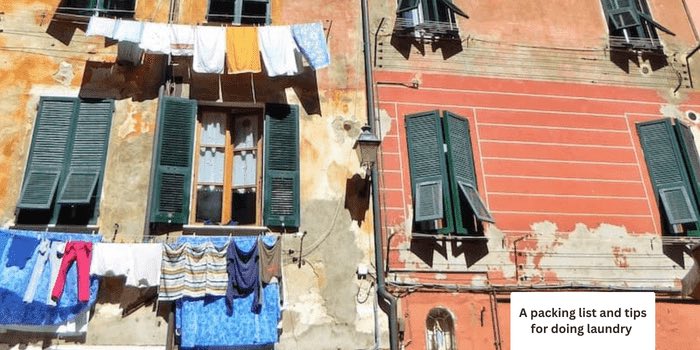




I bring a small vial of concentrated liquid laundry soap and am mindful of bringing only clothes that are fast drying (NO all cotton anything…ever). Most of the time I’ll do a few pieces in the sink and hang/drip dry (if I even end up doing any laundry at all 😉
As for MUST HAVES on my packing list, one thing I use daily is PortaPocket. It’s a multi-functional wearable that keeps my vital items safe, secure & discreet…
it’s easy to use, lightweight & versatile, plus works w/almost any outfit at all,
from casual to fancy.
Happy new year and Cheers to you, from Chicago!
I love how you’ve broken down the list into categories and provided helpful tips for keeping laundry organized and manageable while traveling. The idea of using dry bags for packing clothes is so clever and I’ll definitely be using that for my next trip. I also appreciate the tips for machine washing clothes and how to quickly dry them. This post will be a great resource for anyone planning a trip and looking for tips on how to stay organized with laundry. Thanks for sharing your expertise!
This is a great post. I especially found the tip about using sanitizer as a stain removal helpful. Something I will be putting into practice right away as my go to has been to use dish-soap but that doesn’t seem to be working this trip.
I love the pictures that accompany this post.
Hey Anne,
You know with every article you have so many tips to share that it intrigues me every time.
These laundry techniques during traveling are spot-on.
It is crazy that some people do not wash their clothes at all during traveling and pack so many things that it becomes hectic to move to places.
The realistic pictures that you shared also help.
Thanks a lot.
Keep up the good work.
Haemi @Borderless Comfort recently posted…Plant-Forward: What it Means and Why it Matters
This comprehensive guide to doing laundry while traveling is a treasure trove of practical advice and ingenious tips. The insights about assembling a travel wardrobe, using care labels effectively, and optimizing drying methods are invaluable. The packing list for laundry essentials is a must-read for any traveler aiming to stay fresh on the road.
I take a Ziploc bag with a couple of laundry pods. Each time I use one my luggage gets lighter.
Love this comprehensive guide on managing laundry while traveling. These tips are so useful! It is also worth considering packing a small mesh laundry bag to keep your clean and dirty clothes separate in your luggage – it’s been a lifesaver for me! Thanks for sharing these insights!